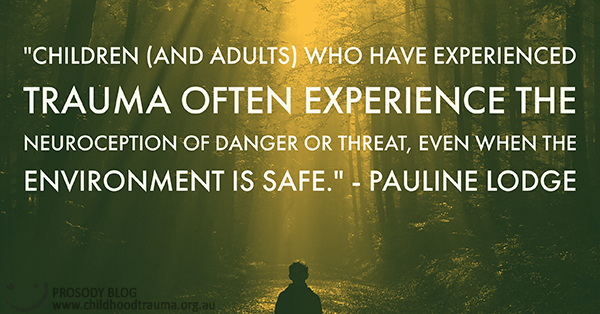
A Modality with a Difference

This blog article was authored by Pauline Lodge, Senior Training Consultant,
Professional Education and Training Program, at the Australian Childhood Foundation.
Do you work with traumatised children or adults? Do you feel, like I do, that perhaps something is missing in the top down, cognitive, behavioural approach to working with trauma? Do you have clients whom you have spent a long time working with to address their traumatic experiences but somehow changing their cognitions is not fully resolving the issue? Are they still experiencing physiological arousal, are they still hyper vigilant  and avoidant of particular stimuli? Is their experience of trauma still impacting their lives despite your best therapeutic efforts? Whilst some of the children and young people I worked with, who have experienced sexual abuse, were able to recover from their traumatic experiences and continue to grow and develop there were a number who continued to live with trauma symptomology on a daily basis. The impact of their trauma evident in the way they engage with the world. Unable to sleep, overwhelmed by shame, avoidant of interactions, hypervigilant for danger, the world feels like an unsafe and dangerous place.
and avoidant of particular stimuli? Is their experience of trauma still impacting their lives despite your best therapeutic efforts? Whilst some of the children and young people I worked with, who have experienced sexual abuse, were able to recover from their traumatic experiences and continue to grow and develop there were a number who continued to live with trauma symptomology on a daily basis. The impact of their trauma evident in the way they engage with the world. Unable to sleep, overwhelmed by shame, avoidant of interactions, hypervigilant for danger, the world feels like an unsafe and dangerous place.
Many of the mothers I have worked with whose children had experienced sexual abuse had been a target of sexual abuse in their own childhood and were battling to manage the triggering of unresolved trauma, despite having participated in counselling or therapy that focussed on cognitions and emotions in the past.
Sensorimotor psychotherapy offered an alternative approach that enabled us to work from the bottom up, addressing the impact of trauma on the body to fully uncouple the traumatic reactions from the traumatic event, thus reducing the physiological trauma symptomology that had remained even after participating in other cognitive or talk based therapies. This method enabled respectful engagement with the legacy of trauma that children and adults experience, using the body as the access route to all of the implicit traumatic memories we hold in our bodies that are not necessarily easily available for cognitive processing.
As I began the process of integrating some of my new sensorimotor knowledge with the psychodynamic processes I was using to work with traumatised clients, one of the things I enjoyed most was the process of embodiment of the principles which underpin the work. Being able to engage with children and families around an experience so utterly traumatic and highly personal such as childhood sexual abuse, using a modality that is built on principles of organicity, non-violence, unity, mind/body/spirit holism and mindfulness, feels like such a respectful, compassionate way to undertake the process of therapy and engage in the therapeutic relationship.
Sensorimotor psychotherapy offered a new way of being in relationship, the embodiment of that felt sense of inner body wisdom, that offered me a belief in the innate ability of our bodies to heal and grow. The concept of organicity, unity and mindful awareness as a therapist and in therapy enabled me to be more attuned to my own somatic experience and the present moment somatic experience of the client in the room.

Stephen Porges coined the phrase neuroception to describe our brain’s ability to perceive safety or threat in our environment. Children (and adults) who have experienced trauma often experience the neuroception of danger or threat, even when the environment is safe. The essence of Sensorimotor psychotherapy interventions offer the opportunity for traumatised children and young people to experience safety in relationship with their therapist. The therapist will carefully track and contact body based indicators of the experience of threat and encourage the client to be mindfully aware of our somatic responses to changes in relationship or the environment, for example by having the client direct the positioning of the therapist in the room. The client is then supported to mindfully observe their present moment experience as the therapist moves further away or closer to them at their direction, until they find a position that feels safe for them. Through this simple process they have the opportunity to experience an embodied sense of safety in relationship.
Sensorimotor psychotherapy offers an insight into the client’s unique experience of trauma and offers a range of interventions that can be targeted to their individual present moment experience, are they experiencing hypo or hyper arousal, are they contained, activated, triggered? In that moment what is going to be useful for them? This honouring of the clients present moment experience and valuing of the wisdom of the body, left me feeling more confident that I could work therapeutically with traumatised clients in a safe and respectful manner, without the risk of ‘re-traumatising’ them.
Editor’s Note: Find out more about Sensorimotor Psychotherapy.
